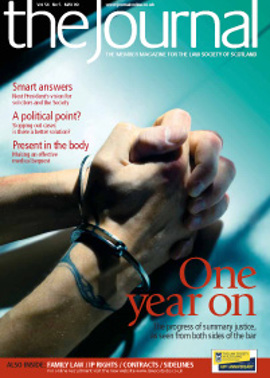Giving up the body

Solicitors may be familiar with clients, at the time of making wills, enquiring about the possibility of leaving their body to medical science. However, such a direction in a will – unless other steps are taken – often results in no action being taken at the time of death.
When the only instruction is in a will, the family have no documentary link with or contact information from an anatomy department and, in the trauma and turmoil of bereavement, contact is not made in time or often at all. For bodies to be suitable for anatomy or surgical training purposes it is essential that they be received for preservation within two days of death. So what steps do solicitors need to take, how can they guide and advise their clients, and what do solicitors need to know since the amendments to the Anatomy Act came into force?
Simplest solution
The preferred arrangement is when intending donors directly contact the most local anatomy department to complete bequeathal documents; this will often be some years before death. Each anatomy department (for which the contact details are supplied below) will provide full information and offer an opportunity to meet the bequeathal secretary so that the process can be talked through and questions answered. Once bequeathal has been signed and witnessed, the anatomy department will supply those bequeathing with two copies of the documentation, one to keep at home, and the other to be supplied to the solicitor to keep with their will. Such witnessed instructions allow the receipt, preservation, and use of the body when death does take place.
Simply put, when bequeathal documents are in place, it is possible when death occurs for the body to go to the anatomy department without there being any instructions in the will. If there is mention in a will, it is also essential that the client be advised by the solicitor to contact the anatomy department to complete bequeathal documents. The written information supplied to those considering bequeathal provides clear and concise guidance on what is involved, and solicitors may find it useful to seek copies so that they too can have a fuller understanding of both the process and the information.
When death does take place, the next of kin will need to access this documentation, and one phone call by next of kin (or a doctor on behalf of the family) will set the intended arrangements in motion. The anatomy department, already holding a copy of the bequeathal documents, will immediately seek information from a doctor who has been involved during the final illness to ascertain the cause of death and to ensure that the body will be suitable.
It is important to note that on rare occasions a body will not be accepted – bequeathal does not guarantee acceptance. Any instruction to allow organ donation takes precedence, and priority is also given when the procurator fiscal wishes to enquire into a death.
The undertaker to the anatomy department can usually transfer the body within a day, and the acceptance documentation, usually completed by next of kin, records the wish for eventual cremation or burial, and return or disposal of ashes. There is a legal requirement that bodies must be sent for cremation or burial within three years of death, and the code of practice requires any separated parts to be returned to the coffin. The anatomy department is responsible for cremation or burial. The acceptance documentation also records whether the next of kin and the family would wish to receive an invitation to the next annual memorial service in the university.
Surgical skills
The 2006 legislation removes the possibility for relatives to donate the body of a family member at the time of their death: it is now a legal requirement that the person themselves must have made formal bequeathal either directly to an anatomy department or in a will.
Until 2006, bodies received by anatomy departments could only be used for traditional anatomy teaching. The most significant innovation when the Anatomy Act 1984 was amended by the Human Tissue (Scotland) Act in 2006 allowed surgical training, including techniques involving implantation of materials. It is already clear that many types of surgical training, both for young surgeons and also to allow fully fledged consultants to extend their operative repertoire, are feasible. It is in all interests that skills be developed and shaped before they are provided to living patients.
Solicitors can be reassured that the legislation imposes the very highest standards of practice in anatomy departments, and rigorous supervision by me as HM Inspector on behalf of the Scottish Government Health Directorates. Unauthorised access to licensed anatomy departments and surgical skills centres is impossible, and every use of bodies must comply with the legislation. There is great privacy, anonymity, and respect.
Medical and dental students continue to need comprehensive knowledge of anatomy and their education absolutely depends upon there being enough donated bodies. They recognise the debt they owe to those whose bodies have been bequeathed, and this is impressively reflected by substantial student attendance at the annual memorial services held by the universities.
The number of bodies being received has been increasing in recent years and has been enough to allow some surgical training developments in addition to traditional anatomy teaching. These developments are increasing and extending very rapidly and will depend upon further increases in bequeathal. It is believed that solicitors, by acting as suggested in this article, may assist in numbers rising in years to come.
I hope that this article assists solicitors to inform and guide clients who are considering bequeathal. We are also intending to convey similar information to general medical practitioners, some of whom are unfamiliar with the bequeathal process and the impact of the 2006 legislation. Later this year we hope to provide a website on body donation in Scotland which we hope will be helpful to members of the public and those assisting them in seeking information.
| University | Bequeathal secretary | Telephone | |
| Aberdeen | Mrs M Moir, Anatomy Dept, Marischal College, Aberdeen AB10 1YS (from August 2009: Matthew Hay Building, Medical School, Foresterhill, Aberdeen AB25 2ZN) |
01224 274320 | m.moir.@abdn.ac.uk |
| Dundee | Mrs V McGuire, School of Anatomy, University of Dundee, MSI/WTB Complex, Dundee DD1 5EH |
01382 388825 | v.mcguire@dundee.ac.uk |
| Edinburgh | Mrs F Mowat, SBMS (Anatomy), Doorway 3, University Medical School, Teviot Place, Edinburgh EH8 9AG | 0131 650 8318 | fmowat@staffmail.ed.ac.uk |
| Glasgow | Mrs A Mellish, University of Glasgow Anatomy Dept, University Avenue, Glasgow G12 8QQ | 0141 330 5397 | a.mellish@bio.gla.ac.uk |
| St Andrews | Mrs S Dye, Anatomy Dept, Bute Medical Buildings, St Andrews, Fife KY16 9TS (address will change in August 2009) | 01334 463596 | sd4@st-and.ac.uk |
In this issue
- Obama's first 100 days
- Playing politics with the Scottish constitution
- Beneficiaries are suffering from the high cost of advice
- Ever forwards
- Shared principles
- A year of debate
- Ask the audience
- Property sales continue to fall
- Where fact makes law
- Giving up the body
- Playing politics with the constitution
- Matrix evolutions
- Make it happen
- View from the top
- Retiring thoughts
- Law reform update
- Phone a friend
- Lighting the way
- Is Big Brother watching too closely?
- Ask Ash
- Selection, the professional way
- A claims pandemic?
- Bumper crop
- A place in the sun?
- Equality redefined
- Taking diligence forward
- Scottish Solicitors' Discipline Tribunal
- Book reviews
- Website review






